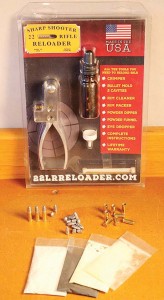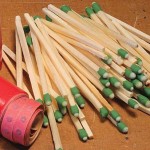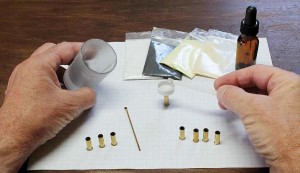by Art Merrill | Contributing Editor
[pullquote align=”right” cite=”” link=”” color=”#FF0000″ class=”” size=””]
CAUTION
The two hazards involved with casting lead bullets are lead poisoning caused by the absorption of lead via touch or by inhaling the vapors from molten lead, and burns or fires caused by the molten lead (the melting point of lead is 621°F). Have good ventilation and wash your hands thoroughly after handling lead. Wear non-synthetic clothing, gloves and eye/face protection. Never allow any kind of liquid or moisture near molten lead. Clamp your furnace or pot to your bench to prevent it tipping over. Detailed safety information is widely available online.[/pullquote]
Everybody knows you can’t reload fired rimfire cases, right?
Well, the guys at Sharpshooter 22 Long Rifle Reloader, LLC just changed everybody’s knowledge. You indeed CAN reload your fired .22 Long Rifle cases using their simple kit containing two tools, a powder dipper and funnel, and eyedropper bottle. A resizing die is sold separately, and we’ll get into that in a bit.
Rimfire obstacles
Two major obstacles block the easy reloading of .22 rimfire ammunition: priming and bullets. While the first may be obvious even to the non-handloader, the lack of available proper bullets might surprise those who think .22s are all the same.
The .22 caliber bullets presently offered to handloaders will not work in the family of .22 Short, Long and Long Rifle cartridges. First, typical jacketed bullets for .22 centerfire cartridges are too large in diameter at .224” because bullet and groove diameters for the .22LR are only .222”. Second is the special heel base bullet needed for the .22LR cartridge.
Unlike other straight wall cartridges, the .22LR bullet diameter is the same as the case diameter. This means that crimping the .22LR case onto the bullet requires that the back of the bullet, the heel, be of lesser diameter than the exposed, case diameter portion of the bullet. At this writing no bullet manufacturer offers these .222” heel base bullets to handloaders. You could cast your own heel base bullets from a custom order mold, but you still have Obstacle #1, how to reprime the rimfire case, because no maker of cartridge primers sells loose priming compound to handloaders – you can imagine how hazardous it would be to ship it.
Solutions
Sharpshooter 22 Long Rifle Reloader gets around Obstacle #1 by shipping the primer compound, called Prime-All, as separate chemicals that are inert until mixed together by the handloader. They beat the heel base bullet obstacle by providing a bullet mold for casting your own lead bullets; the mold also serves to crimp the bullet in the case.
The mold has two cavities, one which throws a common 38-gr. round nose bullet, the other a 25-gr. pointed bullet. If you’ve never cast lead bullets, don’t let that stop you now; there are some specific safety concerns to be aware of, but the basic procedure itself is simple enough that backwoodsmen of the muzzleloader era cast lead muzzleloader balls by their campfires.
Let’s load
After casting your bullets with the mold, the steps in reloading .22LR cartridges with the Sharpshooter kit are pretty much the same as for centerfire  cartridges, and it looks like this:
cartridges, and it looks like this:
- Clean the brass with whatever method suits you (if using a liquid cleaner be sure cases are bone dry before priming).
- Use the flat end of the scraping tool to clean out the fired primer residue under the case rim.
- Resize if needed. Unless you are definitely shooting your reloaded cartridges in the same firearm in which they were originally fired, resizing is in order. If in doubt, try fitting fired cases in your firearm’s chamber before reloading. Sharpshooter sells the proper sizing die (with shellholder) separately.
- Use the provided funnel to add priming compound.
- Add a drop of acetone. Its purpose is not chemical, but physical: wetting the priming material aids in pushing it under the case rim and keeping it there. The acetone will evaporate.
- Use the square end of the rim cleaning tool to tightly pack the wet priming material up under the case rim.
Allow to dry COMPLETELY – overnight is good. Failure to allow complete drying can result in misfires.
- Add propellant according to the included load data, which lists several standard pistol powders as well as Pyrodex P.
- Place a bullet in the case and crimp.
- Shoot cartridge.
- Repeat.
After working with the reloading kit for several months, I have a few observations to share: To prevent misfires be sure to thoroughly clean out the old primer residue and pack the fresh priming compound TIGHTLY under the rim. Adding slightly more primer compound and a second drop of acetone can help.
I resized “range brass” – a random sampling of fired cases I picked up at my club’s shooting range – to evaluate the die and shellholder performance. Virtually none of the brass cases made by CCI would fit in the shellholder because of oversize rim diameter. I noted many other individual cases of other brands would not fit because the case just in front of the rim had “ballooned” out on firing. And the slightest deformation of an empty case mouth results in the die crushing cases.
[pullquote align=”left” cite=”” link=”” color=”” class=”” size=””]

In a pinch, a substitute .22LR priming material is as close as your grocery or hardware store: strike-anywhere matches. The tips of these matches are sensitive enough to use as the priming compound for .22LR cases, but only the tips, not the entire match head. Another suitable priming material is the powder taken from common children’s paper roll caps. In testing, success rate with the match tips was 60 percent; the roll cap powder worked 100 percent of the time.
No powder? Five of those match heads from which you’ve removed the tips, when ground, can serve as substitute propellant; while not ideal, it will drive the lighter 25gr bullet at about 500fps.
[/pullquote]
The dent left in the case rim by the firing pin doesn’t seem to be much of a factor in reloading rimfire cases, though of course a second strike in exactly the same place can result in a misfire. The kit instructions address a method of removing the dent, if you so desire.
The only thing new to handloaders here is the somewhat tedious method of priming the empty cases; you won’t be churning out hundreds of rounds of blasting ammo in a single session. But with the continued drought of .22LR ammunition – and paying $5 per box retail when available compared to about 80 cents per box for reloads – reloading is now an option if you can accept the caveats.




